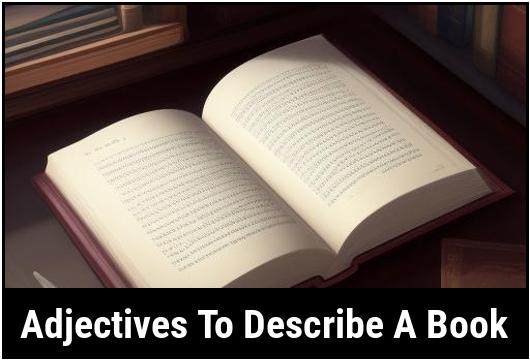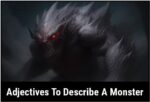- You are here:
- Home »
- adjectives
- » 43 Adjectives To Describe A Book

43 Adjectives To Describe A Book
Adjectives play an important role in conveying the essence and quality of a book. Whether it’s a gripping thriller, a heartwarming romance, or a thought-provoking non-fiction, choosing the right adjectives to describe a book can greatly impact how it is perceived by potential readers. This comprehensive guide will delve into the significance of adjectives in describing books, how to choose the right adjectives, and the various types of adjectives that can be used to effectively capture the essence of a book.
Key Takeaways
- Adjectives serve as powerful tools in conveying the tone, mood, and overall quality of a book.
- They provide vivid and descriptive language to entice readers and provide a clearer understanding of the book’s content and theme.
- Choosing the right adjectives can significantly impact how a book is perceived and received by its target audience.
Adjectives To Describe A Book
-
Enthralling: A book that captivates and holds the reader’s attention from start to finish.
-
Gripping: An intense and exciting book that makes it difficult to put down.
-
Thought-provoking: A book that stimulates deep thinking and encourages readers to ponder complex ideas.
-
Engrossing: A book that immerses the reader completely into its storyline and characters.
-
Riveting: A book that holds the reader’s interest and curiosity throughout its entirety.
-
Illuminating: A book that sheds light on a particular topic or conveys new insights and perspectives.
-
Compelling: A book that compels the reader to keep reading, with a captivating plot or narrative style.
-
Intriguing: A book that sparks curiosity and interest through its mysterious or complex storyline.
-
Atmospheric: A book that successfully creates a particular atmosphere or mood through its descriptive writing.
-
Captivating: A book that captures the reader’s imagination and attention right from the first page.
-
Heartwarming: A book that fills the reader’s heart with warmth and a sense of happiness.
-
Pensive: A book that invites contemplation and reflection on life’s deeper questions.
-
Absorbing: A book that engrosses the reader’s attention completely, making them lose track of time and their surroundings.
-
Memorable: A book that leaves a lasting impression on the reader’s mind and heart.
-
Entertaining: A book that provides enjoyment and amusement, often through humor or engaging storytelling.
-
Relatable: A book that resonates with readers, making them feel understood and connected.
-
Empowering: A book that instills a sense of empowerment and resilience in its readers.
-
Page-turner: A book that is so engaging and exciting that the reader cannot resist turning page after page.
-
Poignant: A book that evokes a strong sense of sadness or sympathy in the reader.
-
Enchanting: A book that casts a spell on the reader, enchanting them with its magical elements.
-
Thrilling: A book that sends shivers down the reader’s spine, often through suspenseful and action-packed sequences.
-
Educational: A book that imparts knowledge, skills, or life lessons to its readers.
-
Creative: A book that showcases the author’s innovative thinking and imaginative storytelling.
-
Emotionally-charged: A book that elicits powerful emotions from the reader, such as joy, anger, or love.
-
Masterful: A book that displays the author’s exceptional skill and expertise in writing.
-
Whimsical: A book that embraces a playful and fanciful tone, often filled with humor or whimsy.
-
Haunting: A book that leaves a lasting impression on the reader’s mind, lingering like a ghostly presence.
-
Inspiriting: A book that uplifts and motivates the reader, inspiring them to achieve their goals and dreams.
-
Unforgettable: A book that is impossible to forget, leaving an indelible mark on the reader’s memory.
-
Magical: A book that transports the reader to a world of enchantment and wonder, where anything is possible.
-
Original: A book that stands out for its unique and innovative approach, setting it apart from others in its genre.
-
Evocative: A book that stirs strong emotions and memories in the reader, creating a deeply personal connection.
-
Compulsive: A book that incites an irresistible urge to read, often due to its addictive and compelling narrative.
-
Engaging: A book that draws the reader into its story or content, making them actively participate in the reading experience.
-
Informative: A book that provides valuable and factual information on a specific topic.
-
Profound: A book that explores profound and thought-provoking ideas, inviting readers to reevaluate their own beliefs.
-
Uplifting: A book that leaves the reader feeling uplifted and optimistic about life and its possibilities.
-
Unputdownable: A book that is so gripping and engaging that the reader cannot bear to stop reading.
-
Nostalgic: A book that evokes a nostalgic longing for the past, triggering fond memories and sentimentality.
-
Imaginative: A book that stretches the limits of imagination, inviting the reader into a world of endless possibilities.
-
Introspective: A book that encourages deep introspection and self-examination in the reader.
-
Inspirational: A book that sparks inspiration and motivates the reader to pursue their dreams and aspirations.
-
Insightful: A book that offers valuable insights and perspectives on various aspects of life and the human condition.
Why Use Adjectives To Describe A Book
Adjectives are essential in book descriptions as they provide nuanced and vivid details about the book, allowing potential readers to form a clearer picture of what to expect. When browsing for books, readers often rely on adjectives in book descriptions to gauge whether the book aligns with their preferences. Moreover, adjectives help differentiate books within the same genre, showcasing their unique attributes and distinguishing characteristics. They have the power to evoke emotions, set the mood, and create a lasting impression on the reader, ultimately influencing their decision to explore the book further.
How To Choose The Right Adjective To Describe A Book
Selecting the right adjectives to describe a book requires a thorough understanding of its content, theme, and target audience. Here are some essential considerations for choosing the right adjectives:
-
Understand the Book’s Theme and Genre: Before selecting adjectives, it’s crucial to comprehend the central theme and genre of the book. Different genres and themes evoke distinct emotions and atmospheres, which should be reflected in the adjectives used.
-
Consider the Tone of the Book: Whether the book is serious, humorous, mysterious, or heartwarming, the chosen adjectives should align with its tone to accurately convey its mood and atmosphere.
-
Identify the Key Selling Points: Highlight the most compelling aspects of the book, such as its unique plot, memorable characters, or thought-provoking narrative, and choose adjectives that emphasize these qualities.
-
Target the Intended Audience: Tailor the adjectives to cater to the preferences and expectations of the book’s intended readers. Different demographics respond to varying adjectives based on their interests and reading preferences.
-
Use Vivid and Descriptive Adjectives: Opt for adjectives that paint a vivid and evocative picture of the book, capturing its essence in a compelling and descriptive manner.
Types Of Adjectives For Describing A Book
When describing a book, various types of adjectives can be employed to convey its unique attributes and qualities effectively. These include:
-
Genre-specific Adjectives: Adjectives tailored to specific genres such as "suspenseful," "heartwarming," "hilarious," "insightful," and "intriguing" can vividly describe the overall tone and theme of the book.
-
Character-based Adjectives: Adjectives that portray the characters in the book, such as "complex," "compelling," "relatable," "enigmatic," and "charismatic," offer insights into the depth and personality of the characters.
-
Plot-driven Adjectives: Adjectives describing the plot and narrative of the book, such as "twisty," "captivating," "emotional," "engrossing," and "unpredictable," provide an indication of the book’s storyline and its ability to captivate readers.
-
Setting-related Adjectives: These adjectives focus on the setting and atmosphere of the book, such as "atmospheric," "eerie," "luscious," "exotic," and "evocative," which evoke the mood and environment in which the story unfolds.
-
Quality-based Adjectives: Adjectives that reflect the overall quality and impact of the book, such as "compelling," "masterful," "poignant," "profound," and "enchanting," showcase the book’s literary merit and emotional resonance.
-
Reader-response Adjectives: Adjectives that anticipate the reader’s response to the book, such as "thought-provoking," "unputdownable," "emotionally-charged," "inspirational," and "mind-bending," can prompt readers to engage with the book on a deeper level.
Adjectives play a pivotal role in effectively conveying the essence and appeal of a book. By carefully selecting adjectives that align with the book’s theme, tone, and key selling points, authors, publishers, and reviewers can create compelling and engaging descriptions that resonate with potential readers. Understanding the diverse types of adjectives and their specific applications in describing different aspects of the book enables a more nuanced and evocative portrayal of its content and qualities. Ultimately, the judicious use of adjectives can enhance the visibility, appeal, and impact of a book, guiding readers to discover literary treasures that resonate with their interests and preferences.
Examples Of Adjectives For Different Types Of Books
When it comes to describing a book, choosing the right adjectives can make all the difference in capturing its essence, enticing readers, and conveying your thoughts effectively. Adjectives are powerful tools that can evoke emotions, paint vivid pictures, and provide valuable insights into the content and style of a book.
-
Fiction Books:
- Captivating: Books that are captivating have a magnetic pull that keeps readers engrossed from start to finish.
- Imaginative: These types of books are filled with vibrant and imaginative storytelling that transports readers to new realms.
- Gripping: Gripping books hold readers’ attention firmly, making it difficult for them to put the book down.
- Suspenseful: Suspenseful books are full of tension and excitement, making readers eagerly turn the pages to find out what happens next.
- Poignant: Poignant books evoke strong emotions of sadness or compassion, often leaving a lasting impact on the reader.
- Thought-provoking: These books inspire deep contemplation and challenge the reader’s perspective on various aspects of life.
- Whimsical: Whimsical books are light-hearted and filled with playful, imaginative elements that make readers smile.
- Enchanting: Enchanting books have a magical quality that captivates readers and leaves them spellbound.
- Thrilling: Thrilling books are packed with excitement, action, and suspense that keeps readers on the edge of their seats.
- Unforgettable: Unforgettable books leave a lasting impression on readers and become etched in their memories.
-
Non-fiction Books:
- Informative: Informative books provide readers with accurate and valuable knowledge on a particular subject or topic.
- Insightful: Insightful books offer profound and thought-provoking perspectives that expand readers’ understanding.
- Educational: Educational books are designed to teach readers new skills, concepts, or ideas.
- Engaging: Engaging books are highly interesting and captivating, making readers eager to learn more.
- Authoritative: These books are written by experts or authorities in their respective fields, lending credibility to the information presented.
- Well-researched: Well-researched books are meticulously crafted with thorough research and reliable sources, ensuring accuracy and credibility.
- Comprehensive: Comprehensive books cover a wide range of topics within a particular subject, leaving no stone unturned.
- Accessible: Accessible books are easy to understand and designed for a wide audience, making complex subjects approachable.
- Enlightening: Enlightening books shed light on new perspectives or ideas, broadening readers’ horizons.
- Inspirational: Inspirational books uplift and motivate readers, often sharing personal stories of triumph and resilience.
-
Mystery/Thriller Books:
- Suspenseful: Suspenseful books are filled with tension and anticipation, keeping readers guessing until the very end.
- Chilling: Chilling books are eerie and spine-tingling, often sending shivers down readers’ spines.
- Intriguing: Intriguing books have complex, puzzling plots that keep readers hooked, eager to unravel the mysteries.
- Gripping: Gripping books tightly grasp readers’ attention and hold it firmly throughout the story.
- Heart-pounding: Heart-pounding books are thrilling and intense, racing readers’ hearts as they delve deeper into the narrative.
- Unpredictable: Unpredictable books keep readers on their toes, with unexpected twists and turns that defy expectations.
- Dark: Dark books delve into the depths of human nature, exploring themes of crime, violence, and moral ambiguity.
- Compelling: Compelling books have a strong allure that compels readers to keep reading, even when they should put the book down.
- Mind-bending: Mind-bending books challenge readers’ perceptions and twist their minds with intricate plots and unexpected revelations.
- Nail-biting: Nail-biting books are so suspenseful that readers find themselves nervously biting their nails in anticipation.
-
Romance Books:
- Passionate: Passionate books are filled with intense emotions, desire, and love that ignite readers’ hearts.
- Heartwarming: Heartwarming books evoke warm and fuzzy feelings, leaving readers with a sense of joy and contentment.
- Tender: Tender books are gentle and touching, focusing on emotional connections and nurturing relationships.
- Steamy: Steamy books are filled with passionate and intimate scenes that set readers’ hearts ablaze.
- Sweet: Sweet books offer delightful and innocent love stories that make readers smile.
- Enchanting: Enchanting books transport readers into a world of romantic enchantment and fairy-tale-like love.
- Swoon-worthy: Swoon-worthy books have romantic heroes or heroines that make readers swoon with admiration and adoration.
- Escapist: Escapist books offer a romantic escape from everyday life, allowing readers to indulge in fantasies and daydreams.
- Emotionally-charged: Emotionally-charged books are filled with strong emotions and raw vulnerability that resonate with readers.
- Hopeful: Hopeful books inspire optimism and belief in the power of love, leaving readers with a warm sense of hope.
Common Mistakes In Using Adjectives To Describe Books
While using adjectives to describe books can greatly enhance your writing, it’s essential to be mindful of common mistakes that writers often make. By avoiding these pitfalls, you can ensure that your descriptions accurately reflect the book’s qualities and engage your readers more effectively.
-
Overusing generic adjectives: Generic adjectives like "good," "great," or "interesting" can be vague and uninspiring. Instead, opt for more specific adjectives that precisely convey the book’s unique qualities and create a vivid description.
-
Using clichéd adjectives: Clichéd adjectives such as "amazing," "mind-blowing," or "unputdownable" have become overused and lack impact. Try to find fresh and original adjectives that bring a unique perspective to your description.
-
Neglecting to provide context: Simply listing adjectives without providing any context or explanation can leave readers wondering about the book’s content and style. Always aim to provide a brief summary or highlight specific aspects of the book that align with your chosen adjectives.
-
Ignoring the target audience: Different adjectives may appeal to different readers. Consider who the target audience is and choose adjectives that resonate with them. What may be exciting for young readers, for instance, may not have the same effect on adults.
-
Failing to back up your claims: It’s essential to support your adjectives with evidence or examples from the book. Show readers why you chose a particular adjective by providing specific instances, quotes, or plot points that demonstrate the adjective’s relevance.
-
Using adjectives alone: While adjectives are valuable tools for description, don’t rely solely on them. Complement the adjectives with well-constructed sentences and paragraphs that elaborate on the book’s strengths, themes, and characters.
-
Neglecting to consider different perspectives: Keep in mind that different readers may have different interpretations and opinions. Acknowledge that your choice of adjectives may reflect your personal taste and perspective, and try to provide a well-rounded description that can resonate with a wider audience.
Using Adjectives Effectively
Now that we have explored various adjectives to describe different types of books and discussed common mistakes to avoid, let’s delve into some tips on how to use adjectives effectively when describing a book.
-
Select adjectives that accurately reflect the book’s qualities: Make sure the adjectives you choose genuinely capture the essence of the book. Consider the themes, writing style, plot, characters, and emotions evoked by the book, and select adjectives that encapsulate these elements.
-
Provide specific examples or evidence: Instead of making general statements, back up your adjectives with specific examples from the book. Describe a memorable scene, quote a powerful sentence, or mention a character’s distinguishing trait to illustrate the adjective’s relevance.
-
Use a combination of adjectives and descriptive phrases: While adjectives alone can convey certain qualities, combining them with descriptive phrases can enhance your description. For example, instead of simply saying a book is "gripping," you can describe it as "a gripping tale of suspense that keeps you on the edge of your seat."
-
Consider the tone and style of the book: Adapt your choice of adjectives to match the tone and style of the book. If it is a lighthearted and humorous book, opt for adjectives that reflect its playful nature. If it is literary and introspective, choose adjectives that convey depth and introspection.
-
Balance positive and negative adjectives: While it’s natural to focus on the positive aspects of a book, don’t shy away from using negative adjectives when appropriate. If a book has flaws or shortcomings, acknowledging them can provide a more balanced and credible evaluation.
-
Create a cohesive and engaging description: Build your description using a combination of adjectives, well-crafted sentences, and paragraphs that flow seamlessly. Take the reader on a journey through the book’s highlights, capturing their attention and making them want to explore the book further.
-
Revise and edit your description: After writing your initial description, take the time to revise and refine it. Look for opportunities to make your writing more concise, vivid, and impactful. Eliminate any unnecessary repetition or redundancy and ensure that your adjectives are used effectively to enhance the overall description.
Exercises And Practice
To further solidify your understanding of using adjectives to describe books, here are a few exercises and practice opportunities:
-
Select a book that you have read recently and write a description using a combination of adjectives and descriptive phrases. Focus on capturing the book’s unique qualities, themes, and emotional impact.
-
Choose a genre of books (e.g., fantasy, self-help, historical fiction) and create a list of adjectives that are commonly associated with that genre. Challenge yourself to find fresh and original adjectives that go beyond the obvious choices.
-
Read book reviews from reputable sources or online platforms and analyze how adjectives are used to describe the books. Pay attention to how the selected adjectives align with the reviewer’s opinions and whether they effectively convey the book’s qualities.
-
Practice writing short book descriptions using adjectives for different types of books, such as fiction, non-fiction, mystery/thriller, and romance. Experiment with different combinations of adjectives to create varying tones and styles.
Conclusion
Describing a book effectively requires choosing the right adjectives that accurately capture its qualities and appeal to readers. By selecting adjectives that go beyond generic descriptors, providing specific examples or evidence, and considering the target audience, you can create compelling and engaging descriptions. Avoid common mistakes such as relying on cliches or neglecting to provide context, and instead, use adjectives as tools to complement well-constructed sentences and paragraphs. With practice and attention to detail, you can master the art of using adjectives to bring books to life in your descriptions.
FAQS On Adjectives To Describe A Book
What Are Some adjectives To Describe A Book?
Keywords such as "vivid," "captivating," "intriguing," "compelling," and "engaging" can be used to describe a book.
Can You Provide Examples Of Adjectives To Describe The Characters In A Book?
Yes, some examples are "complex," "well-developed," "sympathetic," "relatable," and "memorable."
How Can I Use Adjectives To Create A More Engaging Book Review?
Use descriptive adjectives to help readers visualize the book and its characters, share your personal impressions and emotions, and provide specific examples to support your opinions.
Should Adjectives Be Used Sparingly Or Frequently In A Book Review?
Adjectives should be used strategically and in moderation, as too many can dilute the impact of your writing. Choose the most powerful and relevant adjectives to convey your thoughts.
Can I Use A Mix Of Positive And Negative Adjectives When Describing A Book?
Yes, using a mix of positive and negative adjectives can help provide a balanced and well-rounded review. However, be sure to support your opinions with specific examples to give readers a clear understanding of your thoughts.








